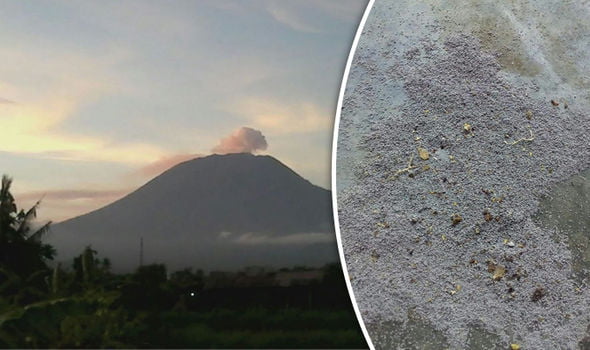

This evening Mount Agubg was still sending a plume of ash up to 1,500m in the sky in what was a beautiful yet ominous sign of the ongoing threat.
More than 70,000 evacuees have fled their homes and are staying in more than 230 shelters across Bali, according to the National Agency for Disaster Management (BNPB)
BNPB spokesman Sutopo Purwo Nugroho ash rained down on Temakung village at 7.50am today when the volcano erupted and sent out ash once again.
The latest Volcano Observatory Notice for Aviation (VONA) was issued after Mount Agung erupted yesterday morning following several days of calm.
The VONA reported an eruption just before 8am local time and said that the ash cloud was estimated to stretch about 5,242m above sea level.
The Volcanology and Geological Disaster Mitigation Agency (PVMBG) has said that greyish-white plumes have soared as high as 2,000m above the crater.
“Sometimes it is hard for the lava and magma to come out, and when there is pressure, it will spew ash,” he told Reuters.
Meanwhile, volcanic earthquakes are continuing to rock Mount Agung, prompting fears that a major eruption could be imminent.
The Indonesians have told about 100,000 people to evacuate from an up to 10m radius danger zone surrounding the volcano.
 Reuters EPA Magma Indonesia
Reuters EPA Magma Indonesia
Bali volcano eruption latest update: Mount Agung sends up plume of smoke
The 3,000m Mount Agung volcano, which is capable of very violent eruptions, has shown a marked increase in activity in the last few weeks, stoking fears of a repeat of the 1963 eruption.
Hot magma has produced an eerie red glow just above the crater, cold lava mudflows have poured the slopes and tens of thousands of villagers have fled homes.
Authorities raised the alert status to the maximum after it started erupting last month, causing travel chaos by closing the island’s airport for three days last week.
Mount Agung eruption, latest pictures

Grey plume above Mount Agung at 08:03 local time. This was one of at least 3 similar sized small plumes seen this morning
It is not possible to accurately predict major eruptions, according to volcanologist Dr Ralf Gertisser, a senior lecturer in mineralogy and petrology at Keele University in Staffordshire.
“We can never accurately predict when a volcano will erupt or the type and size of an eruption; there is always an element of uncertainty,” he said on the university website.
“However, almost all volcanic eruptions have seismic precursors. For example, before the 1980 eruption of Mount St Helens, there was increased seismic activity inside the volcano two months before the eruption.
“Modern volcano monitoring techniques allow us to measure the pulse of a volcano.
“If we have a long-term geophysical and geochemical monitoring record of a volcano that shows signs of unrest, we may be able to better predict, if and when the volcano erupts, and what exact type and size of eruption may occur, if it does so.”
